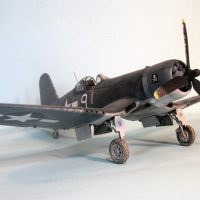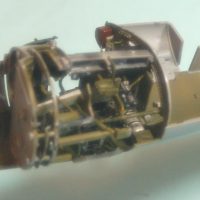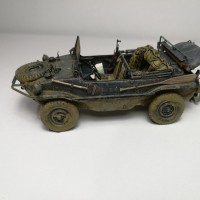Review: Tamiya 1/32 F4U-1A Corsair
Designed in response to a Bureau of Aeronautics request for proposal in February 1938, for a single-engine fighter with a top speed over 350 mph, a landing speed of 70 mph and a range of 1,000 miles, Vought's XF4U-1 Corsair was supposed to become the Navy's fleet defense fighter for the war in the Pacific everyone knew was coming sooner or later. When it first flew in 1940, powered by the first Pratt & Whitney R-2800 engine, which had been designed specifically for the F4U, it was the first fighter in the world capable of 400 mph in level flight. Named the Corsair, it was the first carrier‑based fighter to have a performance superior to its potential land‑based opponents.
After an early crash allowed changes in the weapons system during the rebuild, the requirement for carrying air-dropped bombs in the wings was dropped, while the 4-gun armament was changed to 6 weapons, three in each wing. This meant the fuel tanks had to be moved from the wing, while remaining on the center of gravity. This resulted in the relocation of the cockpit aft to increase fuel in the fuselage tank. This severely restricted the pilot's view during the all‑important maneuver of landing aboard a carrier, with the airplane gaining the names “Old Hosenose” and “Ensign Eliminator”. When that was coupled with overly‑stiff landing gear that had a propensity to bounce when landed aboard by less than an expert pilot, the Navy decided that as good as the airplane was, it was too much of a handful for the average wartime‑trained Navy fighter pilot to safely and consistently operate from the restricted deck of an aircraft carrier and substituted the Grumman Hellcat for the Corsair aboard ship. Interestingly enough, the British took the airplane aboard carriers without the later fixes without difficulty, and VF-17 was able to solve all the problems noted by the time they deployed to the Pacific in September 1943. One has to wonder just what was going on in the cool intelligences at BuAer.
“Butch” Davenport and VF-17
Born in Sterling Michigan on March 14, 1918, Merl W. “Butch” Davenport left Wayne University in his junior year to join the Navy AvCad program, and received his Wings of Gold in May 1942. Shortly thereafter he was assigned to VF-17, which was at the time set to be the first carrier squadron to operate the new F4U-1 Corsair.
Soon promoted to Lt.(j.g.) when his engineering prowess made itself known, Davenport was assigned by squadron leader Tom Blackburn as the engineering officer. He worked closely with the Vought tech reps as the squadron fought to deck-tame the Corsair and was instrumental in developing the spoiler placed on the right wing to give advance warning of stall and thus prevent the deadly snap roll the airplane was capable of during a stall in landing configuration; he was also influential in coming up with the fix to “de-bounce” the Corsair by reducing the pressure in the main gear oleos, as well as the removal of the top three cowl laps to prevent oil smearing the canopy.
Once VF-17 entered combat in the Solomons, Davenport took awhile to get his shooting eye. In January 1943, following the squadron's return for their second tour in Bougainville, he shot down two Zeros. In February he was credited with four on February 16, the last “big day” over Rabaul, and a shared-credit a week later just before the IJNAF evacuated their surviving aircraft back to Truk.
While not one of the highest scoring aces in the squadron, Davenport's efforts as engineering officer were of incalculable importance for VF-17's success in combat, and for the eventual deployment of the Corsair aboard Navy fleet carriers.
The new F4U-1A kit differs from its F4U-1 “Birdcage” predecessor primarily in having the necessary parts for the later bubble canopy of the F4U-1A, along with the different instrument panel, and the Brewster bomb rack used by the F4U-1A as a fighter-bomber in the Central Pacific.
The kit features a detailed R-2800 engine that can be displayed with the cowling open, the option of having the wings spread or folded and the flaps raised or dropped, and the landing gear extended or retracted. The engine is nothing to write home about. It's very definitely not “super-detailed,” and lacks most of the detail one finds in the R-2800s Trumpeter released in their Corsairs, Thunderbolts, Hellcats and Bearcats. Perhaps most importantly, it's still not the right engine for an F4U-1A, but rather for an F4U-1D. This is most notable in the shape of the magnetos. Interestingly, Trumpeter provides the different magnetos as part of their R-2800 package. If one is going to display the model with the engine open, and possesses the now “obsolete” Trumpeter F4U-1A kit, it might be advisable to consider robbing the Trumpeter engine from that kit and using it on this kit.
A lot of complaints have been made about the kit's use of rubber wheels, since it's a “well-known fact” that rubber tires are death to a model. For once and for all: the truth is that there was only ever one airplane kit that had problems with rubber tires: the F7F series released 20 years ago by AMT. There was some sort of chemical reaction between the rubber tires and the plastic hubs, that resulted in them melting. This has not been a problem with kits since. I have Trumpeter kits that are now over ten years old with rubber tires and there has been no problem with any of them. I have used the rubber tires on all the Tamiya Spitfire releases and their Mustang. I used them on the F4U-1. No problem. I am sure, however, that facts will never get in the way of “common knowledge” in the scale modeling hobby, at least in certain places. Were it not for “uninformed comment,” 95 percent of modelers who post on internet forums would be mute.
The one Big Secret to a successful project with this kit is READ AND FOLLOW THE FREAKING INSTRUCTIONS! I realize this is a radical, perhaps subversive act for many modelers to undertake, but just like with the Wingnut Wings kits with their solid instructions, following the way Tamiya has laid this kit out will resolve all your problems.
Another item: while many modelers I know who are working on the kit have reported no problems with the engine, the instructions there as regards getting everything aligned properly in construction are just vague enough that it is very definitely not that hard to end up attaching the front and rear cylinder banks “one cylinder over”, resulting in having to pull it apart and start over (ask me how I know). There is a simple solution to this that will insure everything is assembled correctly here, and that is to assemble everything from back to front: attach the exhausts to the firewall, attach the circular exhaust section to the firewall, then attach the rear engine bank. Attach the exhaust pipes between banks, then attach the front bank. Then attach the front of the engine with the magnetos, and all will be exactly aligned.
Another point about the engine: since it's not that much of a super-detailed whoopy-do, plan to close the cowling (particularly since those parts stay in position about as well as the cowlings on the Spitfires and Mustangs do) and just concentrate on the front of the engine, you can't see anything else anyway.
Now on to building the model.
This kit requires that you carefully clean up each part and remove all bits of sprue attachment, since the fit of this kit is overall tight and precise. If you don't do this, you'll have fit problems throughout the model. Make certain all sub-assemblies are tightly attached in the proper position. “Close enough” doesn't work for this kit.
Unlike the F4U-1, the F4U-1A uses Interior Green throughout for the cockpit and fuselage interiors. If you are modeling a VF-17 airplane, these were early F4U-1As which had the wheel wells and interiors of the gear doors painted Interior Green also. Later F4U-1As had the wheel well and gear doors painted in the lower surface white color. Check your references for the airplane you are doing. VF-17 Corsairs also had the landing gear painted aluminum lacquer.
hen assembling the cockpit interior, it is important to look at the assembly sequence, because there are a parts that fit over other parts and they must be attached in the correct sequence or things will not come together.
With regard to the wing assembly, be absolutely certain to get the upper surface tightly attached to the outer bulkhead of the landing gear well. This is particularly important if you are doing the wings-spread option, since if that is not nice and tight you will not get smooth mating to the outer wing.
Also, for the wings-spread option, do not put any of the parts shown attached inside the folding area. You can't see them and they will get in the way of a good tight fit. While this spar assembly is far stronger than that of the 1/48 kit, it is still a good idea to put some Evergreen strip inside the wing, particularly the area aft of the spar to the flaps. This will provide extra “grabbing area” for the glue and insure a solid fit.
I was glad to see that, for once, the flaps-down option wasn't the only one that worked (as is the case with the 1/48 kits). In the Corsair, it's in the Pilot's Notes to raise the flaps immediately on touchdown because they are liable to foreign object damage on the airstrip, and they blank the prop blast that is important in steering on the ground. I originally liked the flaps-down option back when Tamiya first came out with it, but after looking at the many, many photos of Corsairs with the flaps up and the few with flaps down, I went with technical accuracy and raised the flaps.
The only place I found any fit problem was along the centerline seam of the lower rear fuselage. There was a big seam gap there that took both plastic putty and cyanoacrylate glue to make it disappear. I didn't have to use any filler anywhere else on the model.
Once the model was assembled, it presented a very solid structure.
VF-17 soon replaced their original props with Hellcat props that were a bit shorter and less subject to wear from the coral strips they were flying from. I used a prop from a Hasegawa Hellcat for this model.
The tri-color scheme fades differently from the earlier blue-grey/light-grey scheme. I used Tamiya Flat White for the lower surface, and Tamiya “Medium Blue” which is Intermediate Blue, lightened with some RAF Ocean Grey in the weathering for the lower upper surface. The upper Sea Blue camouflage was done with Tamiya Sea Blue, lightened progressively with Tamiya Field Blue and RAF Ocean Grey. I used pre-shading and post-shading to get the final result.
I had an old Aeromaster sheet that had Davenport's “Lonesome Polecat” with the “9" on a dark blue background. Researching the airplane with my Christmas Present, Lee Cook's “The Skull and Crossbones Squadron: VF-17 in World War II,” I was finally able to figure out that Davenport had three Corsairs during his time in VF-17, all named “Lonesome Polecat” using the same stencil, with no indication of a later airplane in the name. The first was “33" in which he was scoreless. The second was a replacement F4U-1A, with “9" painted directly on the camouflage; he scored two victories in this airplane before Country Landreth managed to overturn it in a landing accident in late January. The third “Lonesome Polecat” was an earlier squadron airplane, a fact that is identifiable on one photograph by the fact you can see the original red surround of the national insignia under the blue repaint. This airplane also had a different earlier number, which was covered with fresh Sea Blue and then two different “9" numerals were painted over on either side. This is the airplane with the eventual six victory flags. It is also interesting to note that this airplane had the white medical tape used to seal the gas tank overpainted with Sea Blue at a later time, since it is darker than the original surface.
I used the Aeromaster decals for Davenport's personal markings, and the red-surround national insignias from the kit, which I then overpainted with Sea Blue, leaving “holidays” through which you can see the original red color. I brush painted Sea Blue over the area where the tape would have been.
I applied extensive exhaust stains on the lower fuselage, using Tamiya NATO Black, Dark Grey and Hull Red. The oil stains aft of the cowling on the fuselage and upper wing were done with thinned Tamiya Semi-Gloss Black, as were the stains aft of the guns.
Photos also show that many of these Corsairs didn't have heavy “dings” so I only lightly “dinged” it with Tamiya flat Aluminum. I used Tamiya “Mud” to “muddy up” the landing gear and wheel wells.
Tamiya's F4U-1 and F4U-1A are definitely the most detailed and accurate Corsair kits yet released in any scale. However, the “miss” with the engine gives an “A-“ rather than “A” grade. For those who love the Corsair, the kit can result in an excellent model, and for those who want to correct all the little details, the result can be an outstanding model. Highly recommended.
When making a Solomons‑based Corsair, I think the following is important information on which to base one's painting and finishing decisions, particularly for Marine Corsairs:
As far as individual airplanes belonging to a specific pilot was concerned, while a man might be assigned an airplane, and while his fighting score might be maintained on that airplane by its crew, the reality was that pilots flew whatever airplane was "in service" at the time the mission was scheduled to take off. (VF-17, being a Navy squadron, was the only one there where pilots had their own airplanes and mostly flew them.) Maintenance in the field on the island airfields was limited to what was necessary to allow the airplane to fly and fight.
Paint faded rapidly under the hot tropic sun, while the "sandblast effect" of operating from a crushed‑coral or dirt runway did nothing to improve the appearance of the fighters, not to mention the "dings" that happened as crewmen climbed over the airplane to service it; exhaust stains and gunfire stains were not washed off at the conclusion of a mission, while the fact that the gas tank leaked meant that the airplane's painted surface became even more corroded from the effects of high‑octane gasoline on it. The result, as can be seen by even the quickest perusal of contemporary photos of Corsairs in the Solomons is that creating an accurate representation of one of these airplanes is one of the few times when "weathering" a model that "too much is not enough" is the rule to follow, rather than the more usual "less is more."



























GREAT Corsair. Love the faded/dusty finish on this one.
Nicely done Tom. As always, I enjoyed reading your historical background on the subject and your building notes as well.
Well done Tom. Love reading the historical background.
very cool
Great Book and Model TC. You forgot to mention that you helped restore a Corsair ...which explains the long article and attention to detail on the model. Rather impressive the pre-shading,the mottling or post shading capture the look and feel of the Corsair. Wish Tamiya would make a Hellcat in this scale.
Hello Tom...my congratulations on a nicely done F4U-1A Corsair. Yours is one of the first that I've seen completed. I liked your choice of markings and enjoyed the information about 'Lonesome Polecat's' pilot 'Butch' Davenport and his Corsairs. Thanks also for the in-progress photos as the model came along. I think photos like that are most helpful for modelers considering that build. Your comments about the problems you encountered were helpful too as most of us manage to step in a few potholes with every build we attempt. The weathering on that Corsair was nicely done too. Good job all the way around. I don't mean to be negative or critical in any way, but I wish the photos had been a bit sharper so I could have better seen the results of your detail work on that fine model.
I agree, Jim...until I read it was a faded tri-color scheme, I didn't even notice that aspect of the finish. Talk about fading in the tropical sun, that demarcation line was so subtle, I missed it completely. You're right...it's hard to see the differences.
Tom, that's a really cool looking Corsair-I too like the weathering you achieved on it and enjoyed the historical background/ build review you included.
Great build, Tom. Subtle finishes.
Great write-up, Tom, and the tips re the building are going to be very useful to anyone tackling this kit. But, I have to agree with Jim and Craig's comments about some of the pictures, especially the close up ones. Do you use a tripod? Maybe you can up the ISO speed which would enable you to use a faster shutter speed?
Lovely finish on this one Tom, and some fantastic detail! It looks like a great kit as well.
Nice job, nice review Tom, a very well made kit.